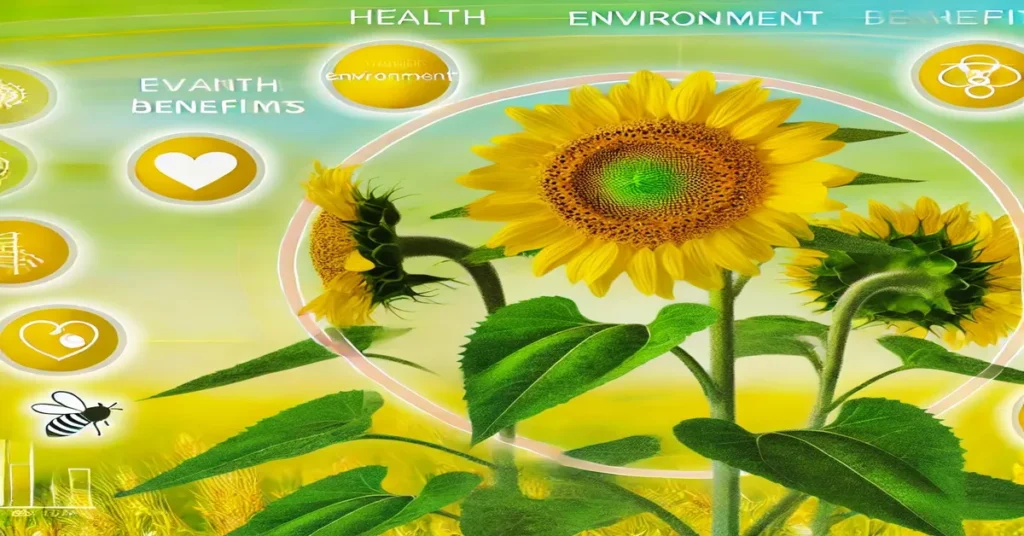The secret life of sunflowers (Helianthus annuus) are among the most recognizable and beloved plants in the world. Known for their vibrant yellow petals and towering stalks, sunflowers are more than just a visual delight—they are complex plants with fascinating biology, significant agricultural value, and a range of beneficial uses. Often seen as symbols of warmth, positivity, and resilience, sunflowers possess unique traits and behaviors that have intrigued scientists, farmers, and flower enthusiasts for centuries.
In this article, we’ll explore the secret life of sunflowers, diving deep into their history, growth cycle, unique characteristics, benefits, and how they contribute to the environment. We’ll also cover their uses in food, industry, and health, providing insight into why these sun-loving plants are so special.
Origins and History of Sunflowers
The sunflower is native to North America and has been cultivated by indigenous communities for thousands of years. Archaeological evidence suggests that sunflowers were first domesticated around 3,000 BCE by Native American tribes, who used the plant’s seeds, oils, and fibers for various purposes, including food, medicine, and ceremonial practices.
When Spanish explorers came to the Americas in the 16th century, they brought sunflower seeds back to Europe, where the plant quickly spread across the continent. By the 18th century, sunflowers had become popular in Russia, where they were cultivated extensively for their oil. Today, sunflowers are grown globally, and sunflower oil remains a staple in many kitchens.
The Life Cycle of a Sunflower
Understanding the life cycle of a sunflower is key to appreciating its unique biological processes and growth patterns. Sunflowers go through a series of stages, from a tiny seed to a towering plant crowned with vibrant blooms. Here’s a breakdown of their growth stages:
1. Seed Germination
- The life of a sunflower begins as a small, hard seed, which can range in color from black to striped.
- When the seed is planted in warm soil and receives adequate moisture, it germinates, sending a root down into the ground and a shoot up toward the light.
- This stage typically lasts about 5-10 days, depending on environmental conditions.
2. Seedling Stage
- Once the seedling emerges from the soil, it develops its first leaves, called cotyledons.
- These initial leaves are followed by true leaves, which will help the plant photosynthesize and grow.
- During this stage, sunflowers are highly susceptible to pests and need regular watering and sunlight to thrive.
3. Vegetative Growth
- In this phase, the sunflower focuses on developing a strong stem and producing more leaves.
- This period of rapid growth can last 3-4 weeks, depending on the sunflower variety and growing conditions.
- Sunflowers can grow several feet in a matter of weeks, thanks to their efficient nutrient and water uptake.
4. Budding
- After the vegetative stage, sunflowers enter the budding phase, where a bud forms at the top of the stem.
- This bud is the precursor to the iconic sunflower bloom and takes around 2-3 weeks to fully develop.
5. Flowering
- The secret life of sunflowers bloom around 70-100 days after planting, producing their characteristic bright yellow or orange flowers with a dark center.
- The head of the sunflower is actually composed of hundreds or even thousands of tiny flowers, called florets, each capable of producing a seed.
- The blooming stage is also when sunflowers exhibit their unique behavior known as “heliotropism” (described further below).
6. Seed Development and Maturation
- After pollination, each floret develops a seed, turning the entire sunflower head into a cluster of seeds.
- Once the seeds mature, the sunflower head will begin to droop, and the petals will wither. This signals the end of the plant’s life cycle.
7. Harvest
- Once the seeds have fully developed, they can be harvested for various purposes, including food, oil extraction, or replanting.
Heliotropism: The Sunflower’s Sun-Tracking Behavior
One of the most fascinating aspects of sunflower biology is heliotropism—the ability of young sunflowers to track the sun. Before a sunflower reaches maturity, it follows the sun across the sky, turning its head from east to west during the day. This behavior is thought to maximize photosynthesis by optimizing the amount of sunlight the plant absorbs.
At night, young sunflowers reset by turning back eastward, preparing to greet the sun again in the morning. Once the sunflower reaches full bloom, it stops moving and typically faces east. This eastward orientation is believed to help attract pollinators, as flowers that face the rising sun tend to warm up faster, drawing bees and other insects early in the day.
The Biology of Sunflower Seeds
Sunflower seeds are not just the product of a beautiful bloom—they are nutrient powerhouses packed with essential vitamins, minerals, and healthy fats. Sunflower seeds come in two main varieties:
- Oilseed Sunflowers: These seeds have a high oil content and are primarily used for extracting sunflower oil. They are typically small, black seeds with thin shells.
- Non-Oilseed (Confectionery) Sunflowers: These larger seeds have a lower oil content and are commonly used as a snack or ingredient in foods. They often have striped shells and are sold as shelled or unshelled seeds.
The nutritional profile of sunflower seeds makes them highly beneficial. They are rich in vitamin E, magnesium, protein, and healthy fats. Consuming sunflower seeds can help reduce inflammation, support heart health, and provide a healthy source of energy.
The Benefits of Sunflowers
Sunflowers provide a wealth of benefits beyond their visual appeal. From environmental contributions to culinary and industrial applications, sunflowers are remarkably versatile.
1. Environmental Benefits
- Soil Health: Sunflowers have deep roots that help aerate the soil, which can improve its structure and fertility.
- Phytoremediation: Sunflowers are used in phytoremediation, a process where plants remove toxic substances from the soil. Sunflowers are particularly effective at absorbing heavy metals, such as lead and arsenic.
- Pollinator Attraction: Sunflowers are pollinator magnets. Their large blooms attract bees, butterflies, and other beneficial insects, supporting biodiversity in the area.
2. Culinary Uses
- Sunflower Seeds: These are a popular snack and are also used in salads, baked goods, and trail mixes.
- Sunflower Oil: Extracted from oilseed sunflowers, sunflower oil is a popular cooking oil that is low in saturated fat and has a high smoke point.
- Sunflower Sprouts and Microgreens: Sunflower sprouts are nutrient-rich and can be used in salads, sandwiches, and smoothies.
3. Health Benefits
- Nutrient-Rich Seeds: Sunflower seeds provide essential nutrients, including vitamin E, magnesium, and selenium, which support heart health, immunity, and skin health.
- Anti-Inflammatory Properties: The healthy fats in sunflower seeds, particularly linoleic acid, may reduce inflammation, which is linked to chronic diseases.
- Rich in Antioxidants: Vitamin E and other antioxidants in sunflower seeds help combat oxidative stress and promote cellular health.
4. Industrial Uses
- Biofuel Production: Sunflower oil can be used as a biofuel, offering a renewable energy source.
- Animal Feed: Sunflower meal, a byproduct of oil extraction, is high in protein and is often used as animal feed.
- Natural Dyes: Sunflower petals can be used to create natural dyes for fabrics and crafts.
5. Ornamental Uses
- Sunflowers are popular in gardens and as cut flowers due to their striking appearance.
- They are used in landscaping to create focal points or natural fences due to their height and bright color.
Growing Sunflowers: A Guide for Gardeners
The secret life of sunflowers are relatively easy to grow and can thrive in various environments. Here are some tips for cultivating sunflowers at home or in the garden:
1. Selecting the Right Variety
- Giant Varieties: Varieties like ‘Mammoth’ can reach heights of 12 feet and produce large flower heads. These are excellent for landscaping or creating a visual impact.
- Dwarf Varieties: For smaller spaces or containers, dwarf sunflowers like ‘Teddy Bear’ grow to only about 2 feet tall.
- Branching Varieties: Some sunflowers produce multiple blooms per plant, providing a longer flowering season.
2. Planting
- Soil: Sunflowers prefer well-draining, loamy soil with a neutral to slightly acidic pH.
- Sunlight: As their name suggests, sunflowers need full sun—at least 6-8 hours of direct sunlight daily.
- Spacing: Sunflowers need ample space to grow, especially larger varieties, which should be planted about 2 feet apart.
3. Watering and Fertilizing
- The secret life of sunflowers require moderate watering, especially during their early stages. Over-watering can cause root rot.
- Fertilize sunflowers with a balanced fertilizer to support growth, particularly in poor soil conditions.
4. Pest and Disease Management
- Common pests include aphids, caterpillars, and beetles, which can be managed with organic insecticides or natural predators.
- Fungal diseases like powdery mildew can affect sunflowers, particularly in humid climates. Proper spacing and avoiding overhead watering can help prevent these issues.
5. Harvesting
- The secret life of sunflowers seeds are ready to harvest when the flower heads turn brown and dry out.
- To harvest, cut the flower head off the stalk and let it dry completely. Seeds can then be removed and stored or roasted for consumption.
Symbolism and Cultural Significance of Sunflowers
Throughout history, sunflowers have been symbols of various positive qualities, including:
- Loyalty and Longevity: In many cultures, sunflowers represent loyalty and long life due to their sturdy growth and enduring bloom.
- Positivity and Happiness: The bright, sunny appearance of sunflowers has made them symbols of happiness, warmth, and optimism.
- Worship and Faith: In some traditions, sunflowers represent faith and worship, as they turn to face the sun, symbolizing adoration.
Artists like Vincent van Gogh famously captured sunflowers in their work, further enhancing the flower’s status as an emblem of beauty and resilience.
Conclusion
The secret life of sunflowers is more than just a beautiful plant; it is a marvel of nature with unique biological characteristics, a rich history, and a multitude of uses. From its sun-tracking abilities to its role in environmental health, culinary applications, and industrial uses, the sunflower is a truly versatile plant that offers numerous benefits. Whether you’re a gardener, a health enthusiast, or simply someone who enjoys their bright blooms, sunflowers have something special to offer.
FAQs about Sunflowers
- Why do sunflowers follow the sun? Young sunflowers exhibit heliotropism, where they follow the sun to maximize sunlight absorption for photosynthesis. Mature sunflowers usually stop this movement.
- Can I eat sunflower seeds straight from the plant? Yes, sunflower seeds are edible. However, they are often roasted and seasoned for flavor. They can also be eaten raw.
- How tall can sunflowers grow? Some sunflower varieties, like the ‘Mammoth’ sunflower, can grow over 12 feet tall, while dwarf varieties may only reach 2 feet.
- What are the main health benefits of sunflower seeds? Sunflower seeds are rich in vitamin E, healthy fats, and antioxidants, which support heart health, reduce inflammation, and boost immunity.
- How are sunflowers beneficial for the environment? Sunflowers improve soil health, support pollinators, and can be used in phytoremediation to clean contaminated soil.
- Can I grow sunflowers in containers? Yes, dwarf sunflower varieties can be successfully grown in containers, provided they receive enough sunlight and are watered regularly.







